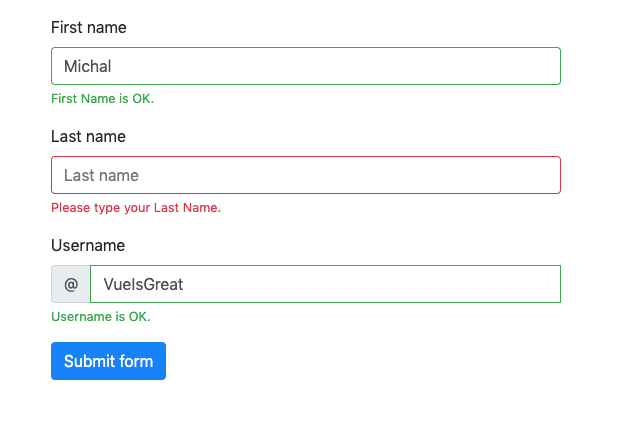Introduction
This time we want to show you how to quickly add very simple form validation using VUE.js – without knowing this library 🙂
Case: We want to add simple but dynamic validation for one of the Bootstrap forms.
Conditions/assumptions:
- we cannot rewrite everything with React,
- we don’t have much time and need to work with an existing HTML code,
- it supposes to be a simple frontend addition – not rocket science,
- we know that VUE.js exists.
Step 1: Read the documentation (or a crash course)
It’s always a good place to start.
Project page: https://vuejs.org/
Official documentation: https://vuejs.org/v2/guide/
Polish crash course: https://typeofweb.com/2018/06/08/wprowadzenie-do-kursu-vue-js-od-podstaw/
English course: https://laracasts.com/series/learn-vue-2-step-by-step
Step 2: Describe the feature
We want to:
- validate three fields: firstName, lastName, and userName – this will be our models,
- have a couple of requirements for every field (e.g. minimal length),
- show only one error message – even if more requirements aren’t meet,
- show a success message for a given field if all rules are passed,
- clear validation result after a field is focused,
- display all error/success messages only after the form was sent,
Step 3: Add VUE.js files to the page
Basically, we can copy the code from docs mentioned before.
<script src="https://cdn.jsdelivr.net/npm/vue"></script>
Step 4: Create the VUE.js application
It’s a good idea to follow the MVC pattern. Models and Controllers will be defined in the app, and for the View, we will update the existing HTML structure.
We already defined models: firstName, lastName, and userName. Additionally, we want to have a placeholder for valid/invalid messages.
var app = new Vue({
// mounting point
el: '#Form',
// defined models / variables
data: {
// basic models
firstName: 'Name', // you can set default values here
lastName: '',
userName: '',
// messages
validation: {
invalid: {
// will be set by validate method; example content:
// [model_name]: 'message',
},
valid: {},
},
},
// defined methods
methods: {
validate: function () { /**/ },
clearValidation: function (field) { /**/ },
},
});
Step 5: Add VUE directives to the HTML code
Models defined – let’s update our View part now. Pay attention to all attributes starting with “v-“.
Make validation results visible only if the given message is defined:
v-if = condition – show given tag only if condition is meet
{{ variable.name }} – show given variable (must be regiesterd before – in loop or data section in Vue app)
<div class="valid-feedback">Hardcoded positive validation information</div>
<div class="invalid-feedback">Hardcoded negative validation information</div>
after:
<div class="valid-feedback" v-if="validation.valid.firstName">{{ validation.valid.firstName }}</div>
<div class="invalid-feedback" v-if="validation.invalid.firstName">{{ validation.invalid.firstName }}</div>
Define models
v-model = modelName – attach model to a form control (two-way data binding)
v-bind : attributeName = attributeValue – calculate and assign attribute value to the HTML tag (v-bind part can be removed to use shorter version :attributeName=…).
v-bind : class = { className: condition, … } – notation like JS object; apply given class name if the calculated condition is true.
v-on : eventType = handler – attach an event handler for event of type eventType handled by handler. Can be an expression or function defined in methods section of Vue app.
<input (...) v-model="firstName" v-bind:class="{ 'is-valid': validation.valid.firstName, 'is-invalid': validation.invalid.firstName }" v-on:focus="clearValidation('firstName')">
Define validate and clearValidation methods.
To access model and defined variables simply use this.<variableName> notation.
(...)
validate: function () {
if (!this.firstName) {
this.validation.invalid.firstName = 'Please type your First Name.';
} else if (this.firstName.length < 2) {
this.validation.invalid.firstName = 'First Name should have min. 2 characters.';
} else {
this.validation.valid.firstName = 'First Name is OK.';
}
(...)
}
Note that VUE is handling the state of defined variables using shallow comparison (fast but not accurate).
Because we’re changing model really deeply (this.validation.valid.firstName) we need to inform about that by using this.$forceUpdate();
clearValidation: function(field) {
this.validation.valid[field] = '';
this.validation.invalid[field] = '';
this.$forceUpdate();
}
Step 6: Summary and… homework
That’s all. After adding a couple of lines the magic of VUE.js just works.
You can find an example working code on CodePen: https://codepen.io/michalzieba/pen/gNwqVx
Here you can find a quick comparison with Angular and React: https://medium.com/@TechMagic/reactjs-vs-angular5-vs-vue-js-what-to-choose-in-2018-b91e028fa91d
For the homework you can think about upgrading the script:
- display every possible error message for a given field using a v-loop,
- the same but with displaying joined messages generated by the defined method (e.g. {{ showErrorMessagesFor(<fieldName>) }} ),
- create a component to handle simple input with validation,
- write a simple form generator from a defined data structure.



Leave A Comment